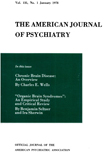AN EXPERIMENTAL STUDY OF MENTAL PATIENTS THROUGH THE AUTOKINETIC PHENOMENON
Abstract
The autokinetic phenomenon is the visual experience of apparent movement of a stationary object, and can be observed most effectively by looking at a fixed pin-point light in a totally dark room.
The phenomenon is offered here as a projective measure of personality structure, and in this sense is used as a diagnostic indicator in mental illness. The test has a proven high reliability. An index figure into which various aspects of the movement pattern is calculated is used for each subject. The movement is more pronounced in schizophrenia, epilepsy, psychasthenia, neurasthenia and anxiety states. In the manic-depressive and involutional psychoses, and in conversion hysteria, movement is, as a rule, either absent or much less extensive.
Atypical test results are discussed in the light of more detailed diagnostic opinions of the staff of the hospital in which the tests were given. Prognostic indications are found in the extent and patterns of movement. Limited or medium amount of movement may be considered prognostically more favorable than extensive or no movement. Fairly accurate limits, expressed in indices, have been established in this connection. Erratic movement patterns presage, on the average, a less favorable course of illness. Sex differences are shown in that more men than women observe autokinetic movement.
Under comments some implications and analogies are presented to show relationships between autokinesis and mental disturbances, and some suggestions are offered for further investigation.
Access content
To read the fulltext, please use one of the options below to sign in or purchase access.- Personal login
- Institutional Login
- Sign in via OpenAthens
- Register for access
-
Please login/register if you wish to pair your device and check access availability.
Not a subscriber?
PsychiatryOnline subscription options offer access to the DSM-5 library, books, journals, CME, and patient resources. This all-in-one virtual library provides psychiatrists and mental health professionals with key resources for diagnosis, treatment, research, and professional development.
Need more help? PsychiatryOnline Customer Service may be reached by emailing [email protected] or by calling 800-368-5777 (in the U.S.) or 703-907-7322 (outside the U.S.).



